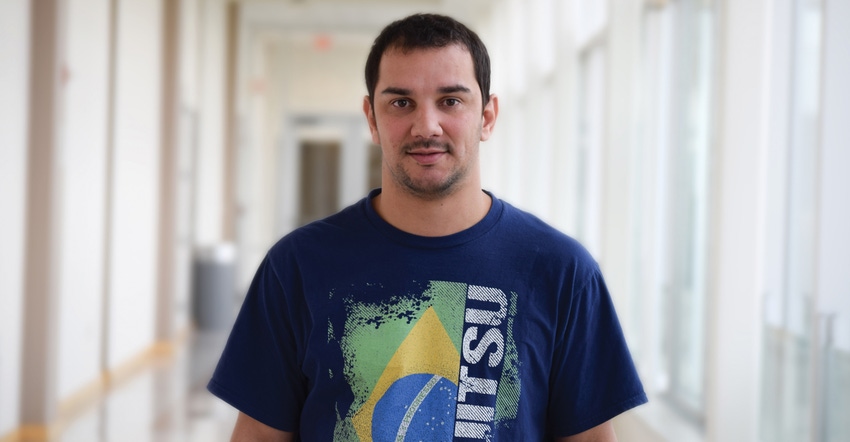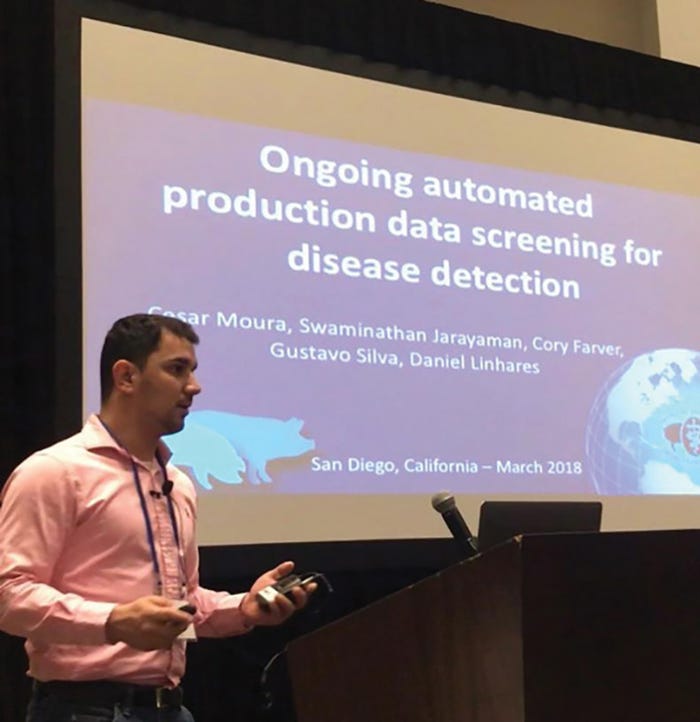Iowa State University doctoral candidate revolutionizes PRRS vaccination protocols.

Cesar Moura is often asked why he has dedicated his entire doctoral degree to studying porcine reproductive and respiratory syndrome. After all, the disease is not present in pig populations in his native country, Brazil.
“I believe that I learned a lot working with the PRRS virus — surveillance techniques, control and elimination programs, statistical models, immunization strategies, epidemiological methods, biosecurity aspects — that can be applied to many other agents,” Moura says.
Two years into his doctoral program at Iowa State University and after conducting several studies on epidemiological and immunological solutions for PRRS virus control, Moura’s preliminary results have already motivated production systems to reassess and modify their vaccination protocols for PRRS, targeting better return over investment.
Along with his seven-chapter Ph.D. thesis, Moura has been working on five other PRRS projects.
“He has extraordinary ability to ‘connect’ with veterinarians and producers, understanding their needs and proposing solutions to address questions with applied science,” says Daniel Linhares, assistant professor and director of graduate education for the Iowa State University College of Veterinary Medicine.
In addition to his research contributions thus far, the rising star has a relentless dedication to helping the industry control and eliminate one of its most costly swine diseases.
Brazil and beyond
The doctoral candidate grew up in Minas Gerais, a state in southeastern Brazil. Many of his family members worked with both cows and pigs. However it was his dad (Cesar), an animal scientist, and his Uncle Sandro, a veterinarian, who worked with pigs and furthered Moura’s interest in pork production.
“I always looked up to them, and that’s why I became interested in the swine industry,” Moura says.
In 2008, Moura set off to obtain his veterinary medicine degree at Universidade Federal de Uberlândia in Brazil. During that time, he explored the industry through internships locally and internationally.
From 2009 through 2012, Moura’s internships in Brazil were based at farms near his hometown and veterinary school, where Moura says he gained valuable experience working with different pork production systems.
In 2012, Moura decided to broaden his horizons and came to the U.S. Midwest, to work as a trainee at LB Pork Inc. in Fairmont, Minn. His tasks included performing wean-to-finish chores, loading pigs to market, running the mill, hauling feed and helping with harvesting corn.
“I was there for one year, learning, working and getting to know how pork production was here in the U.S.,” Moura says.
Upon his return to Brazil, he took another job as a trainee at Brasil Foods (BRF), Brazil’s largest pork producer and then finished his veterinary degree, graduating in 2015.
Moura’s first job out of veterinary school was for Agroceres PIC, a company established in 1977 through a joint venture between the Agroceres Group and PIC (Pig Improvement Co.), implanting in Brazil the first genetic nucleus of elite animals.
During his two years at the firm, Moura worked in technical services, focusing on gilt development and reproductive management. While he enjoyed his new career as a veterinary practitioner, Moura says he saw room for improvement.
“When I was in this company, I was working a lot on reproductive consulting on sow farms in Brazil, and I saw the opportunity for improving my analytical thinking and working with numbers,” Moura says.
Need for numbers
He set his sights on returning north for his studies — this time to Iowa — and immediately contacted Linhares, his former boss at Agroceres PIC, who was now based as a professor at ISU. “All the field-applicable studies that were going on here at Iowa State fascinated me and that’s why I decided to come.”
Moura joined the ISU swine medicine team in 2017 to work on his doctorate in population sciences in animal health, and he’s been conducting studies on epidemiological and immunological solutions for PRRS virus control ever since.
His thesis title is the “Effect of PRRSV MLV interventions on performance of growing pigs from endemic sow herds and placed at high pig dense area, under field conditions.”
When completed, the dissertation will include research on the dynamics of PRRS virus infection on vaccinated growing pigs raised in high pig-density areas; the impact of modified live virus mass intervention of sows on growing pig performance; the effect of partial versus full-dose MLV vaccination on growing pig production; the production and economic benefit of two PRRS MLV doses compared to a single-dose vaccination program on growing pigs; and the assessment of the therapeutic effect of piglet MLV vaccination in the face of a PRRS outbreak.

Producers taking note
Preliminary results from some of Moura’s studies have already shown promise, motivating several systems to change or update their vaccination protocols. One example is a single versus double MLV dose program on growing pigs.
“We have seen significant improved results of the double-dose protocol, especially on reducing mortality of pig groups from PRRSV stable and unstable sow farms,” Moura says.
Another example is his work with full PRRS MLV vaccination dose versus partial dose on growing pig populations.
“In scenarios where the pigs are placed in high pig-dense areas, where they’re more likely to be exposed to the field virus, we are seeing that a full dose of MLV brings production benefit through average daily gain and feed conversion. We have also conducted economic models, and have seen that the extra half-dose of vaccine is significant,” Moura says.
Moura has already presented some of this data at Boehringer Ingelheim’s 2019 American Association of Swine Veterinarians Pre-Symposium, and he hopes to present the results further at the 2019 North American PRRS Symposium in November or at the American Association of Swine Veterinarians conference next year.
“I am very excited, because producers have already been contacting me, asking more about the results of other studies, and there are some producers that have already changed their protocols of vaccinating growing pigs against PRRS,” Moura says. “This is very motivating to keep studying, to keep analyzing and to try to come up with better methods to control PRRS.”
Density, different strains
Moura has also been examining the different dynamics of PRRS infections. Following vaccinated pigs that have been placed in high-density pig areas of Minnesota and North Carolina, the doctoral candidate has been collecting oral fluids over time to measure the association of PRRS virus infection dynamics and performance.
He’s also been observing the difference in productivity between groups of pigs infected with one virus strain, versus two or more, and recording the impact of virus genetic diversity on closeout performance.
Moura hasn’t limited his research to MLV vaccination on grow-finish pigs. He is also studying the impact of MLV mass vaccination on sows and their progeny.
“It is common nowadays to mass-vaccinate endemic sow herds for PRRSV with MLV vaccine. In other words, to vaccinate all females present in that farm. One of my studies is to investigate if this mass vaccination process is associated with any change in productivity on growing pigs weaned right after the process,” Moura says.
The final chapter in Moura’s thesis is in the design phase, and he is now reaching out for producers to enroll farms in the study. The researcher is looking for a PRRS virus-positive, unstable sow farm, with clinical signs, to test out two different piglet vaccination protocols.
One is going to be one dose of PRRS MLV vaccine at processing. The other protocol would be one dose of the same vaccine at processing and another dose at weaning. There will also be a control group, with no PRRS MLV intervention.
“We expect to vaccinate different groups with different protocols, and follow the pigs from the wean-to-finish phase to see which group performs better,” Moura says. “The unique thing of this study is that the pigs are all coming from PRRSV-positive, unstable sow farms.”
Side projects
In addition to his thesis projects, Moura is actively involved in five other research projects.
The Journal of Swine Health and Production has accepted his study “Reporting characteristics of swine intervention trials published prior to and following publication of the REFLECT [an evidence-based minimum set of items for trials reporting production, health, and food-safety outcomes] statement.”
His paper “Understanding factors associated with wean-to-finish mortality: How to minimize losses in your production system” was published at the 2018 scientific conference SINSUI (the Portuguese acronym for International Symposium of Swine Culture) in Brazil.
The Porcine Health Management journal has also accepted another one of his works, “Assessment of immediate production impact following attenuated PRRS virus vaccination in endemically infected breeding herds.”
Moura is currently conducting a project to earlier identify PRRS virus outbreaks in sow herds. It is a website with an ongoing automated process to capture production data from sow farms that will notify users when there is a significant change in productivity that might be related to a PRRS virus outbreak, or other infectious or noninfectious causes of variation.
“The goal is to identify disease outbreaks as early as possible. Basically, we have the farms in the system, and the farm staff update some key production parameters from each farm every week, like number of aborts, preweaning mortality, neonatal losses and sows off feed,” Moura says. “Then, the website runs some statistical analysis and reports if there is a significant deviation in productivity. It might be related to PRRS or another disease, so that’s a way to early detect outbreaks.”
Productivity in practice
Moura hopes to complete his doctorate in 2020 and return to the field working as a veterinarian, where he can apply all of the analytic techniques he has been perfecting over the last few years at ISU.
He is open to staying in the U.S. after graduation and working for a vaccine or genetics company, or within a pork production system.
Regardless where Moura ends up, the young veterinarian says he hopes he will be able to better serve producers with his newfound analytical expertise.
“That’s what excites me the most: to go out in the field using epidemiological concepts to help the industry improving productivity of pig farms,” Moura says.
“I enjoy working on techniques to help producers in case of any disease outbreaks, trying to come up with better numbers and better solutions that will actually improve the output of the farms, and improve the performance and productivity of the herds.”
About the Author(s)
You May Also Like





